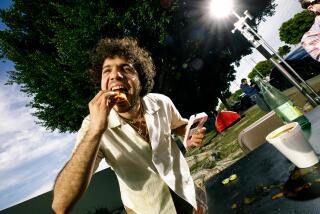Chef’s Trying New Recipe for Cooking Show
- Share via
NEW YORK — As television has bubbled over with cooking shows in recent years, practically any celebrated chef who wanted his own program got one.
With two highly regarded Mexican restaurants in Chicago, an award-winning cookbook and a line of Mexican sauces, Rick Bayless would have seemed a natural for his own show. Yet his last television series, aside from numerous appearances on everyone else’s shows, was the 1978-79 public television series “Cooking Mexican,” which he hosted but didn’t cook for.
Finally, Bayless is jumping into the genre with his series “Mexico: One Plate at a Time.” The 26-episode program made its debut in L.A. last weekend on public station KCET, where it airs at 11 a.m. on Saturdays, and will continue to roll out at stations across the country this summer. A companion cookbook is due in the fall.
Part of the reluctance, Bayless says, was that as a guest on other shows and from watching the programs, he “found the genre really stuck in a rut, and I didn’t want to do more of that.” His interest is the connection between cooking and culture, but he found the food culture shows frequently looked more like travelogues and cooking series often end up “more like background. You can have it on while you’re doing something else; you don’t have to watch intently.”
“It’s gotten boring on public television,” he says. “A lot of the shows have not kept up: They’re slow-paced, with low production values.” Meanwhile, Bayless says cable’s Food Network “took it in the other direction, and decided to just be entertainment.” He describes his experience as a guest on Food Network’s hit show starring New Orleans chef Emeril Lagasse as “like being in a rock concert; it’s so much fun . . . but I’m not sure it has a whole lot to do with cooking.”
So when they decided to do their own show, members of his team set out to reevaluate the genre and use “television as a medium that can take you places,” with short segments and quick side trips to Mexico whenever an unusual ingredient in a recipe comes up.
Producing the series in-house, Bayless’ company hired director Chris Gyoury, who came out of film and television commercials and had never done a food show before (his “Good Eats” has since been picked up by Food Network).
The show moves easily between the kitchen and Mexican archeological ruins and restaurants: an enchilada episode jumps from a Mexican market to Bayless’ Chicago kitchen to the Mexico City restaurant where enchiladas suizas originated. Unlike many other cooking shows, the program is shot entirely with hand-held Steadicams, so when Bayless is cooking, the camera follows him from behind the counter or cooktop instead of from in front, where viewers see everything in reverse and with a sense of remove.
“We have totally underestimated how much of a disconnect that was for viewers,” Bayless says of the traditional style.
One thing Bayless is watching warily is the celebrity-hood that TV has conferred on other chefs, which can result in an influx of new visitors to their restaurants, sometimes at the expense of longtime regulars. He’s happy to be able to bring his message of accessible Mexican cooking to a larger audience, he says, partly because “I love Mexican food and think it’s been very poorly represented in our country.”
Still, he and his wife, Deann, with whom he runs the restaurants Frontera Grill and the more formal Topolobampo, worried about what he calls “the diluting factor of celebrity, something we’re working very hard to step back from. . . . That was a major part of the discussion: Could we handle that?” Bayless thinks the seasonal nature of Chicago’s mostly summer tourist rush, when their regular customers are out of town, will allow the restaurants to accommodate both groups.
And he can’t be too worried: After waiting so long to do a first series, there’s already a second one in the planning stages: 13 episodes about chile peppers, from growing to harvesting to cooking with them.
More to Read
The complete guide to home viewing
Get Screen Gab for everything about the TV shows and streaming movies everyone’s talking about.
You may occasionally receive promotional content from the Los Angeles Times.






